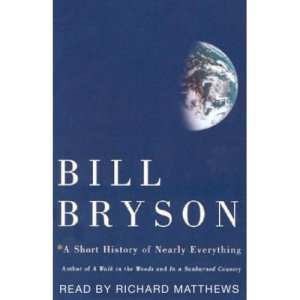
At times, this book felt like factoid upon factoid, strung together with witty Bryson commentary. Which, I suppose, it is. He goes through the whole body, system by system, expressing wonder at the complexities and also presenting the related biological and medical science history. Of necessity, the information in the book is a mile wide and an inch deep, but Bryson really is an entertaining author. He’s not a science expert at all, just a well-read layperson with a gift for explanation, but the book has a substantial set of citations so I don’t have any reason to doubt anything.
Anyway, my big take away was how complex our bodies and biology really are. There’s so much going on, all at the same time. Countless multitudes of confounding factors and problems unamenable to easy study result in Bryson writing something like “the experts really don’t know” every other page or so. It is amazing how much medical advancements have come in the past hundred years or so, despite us not really understanding the full picture of what’s going on for hardly anything biological at all.
Another (related) thought is how we might have already exhausted the low-hanging fruit; any future improvements will take lots of effort to achieve. But fortunately the low-hanging fruit got us pretty far. Bryson has a paragraph in the closing chapter where he says “if we found a cure for all cancers tomorrow, it would add just 3.2 years to overall life expectancy.” Heart disease, 5.5 years. Alzheimer’s, only 19 days. This is because each of those individually is rarer than average, and overwhelming afflict the elderly who have many other things to die from. I guess aging in general is really the thing that needs to be tackled. Also, the quality of life, not just longevity, needs to be improved — Bryson reports far too many people, close to 50%, have some sort of chronic pain they are dealing with. Something to keep in mind when interacting with strangers…be kind, you don’t know what people are going through!
I started keeping notes on some interesting factoids, but kind of lost track since (as I said above) that’s pretty much the gist of the book – interesting factoid upon interesting factoid. Anyway, here are a few I did record:
- Individual hairs on our head will last about 5-7 years.
- The total number of human cells and microbe cells in a body are about evenly split, 30 trillion each.
- The area your eyes can focus on is only the size of your fingertip held at arm’s length. To compensate, our brain is constantly reconstructing the scene around us. Our eyes dart about frequently without us really knowing it.
- Similarly, the flavor of food is constructed in the brain from a mix of visual, smell, and taste sensors.
- The chin doesn’t really have a biological purpose. Same with eyebrows and eyelashes.
- Humans are the only mammal to release tears as emotional response. Also we are one of the few mammals to have the “whites of our eyes” – it is thought that these (and maybe those eyebrows/chin) are useful in facilitating silent communication among hunting parties. Conversely, for most other animals dark eyes are preferred for avoiding being spotted at night by predators.
- Lots of suboptimal things in our bodies: heart tissue and ear hairs which detect high frequencies and many other organs don’t regenerate; our propensity for choking due to shared air and food tube arrangement.





